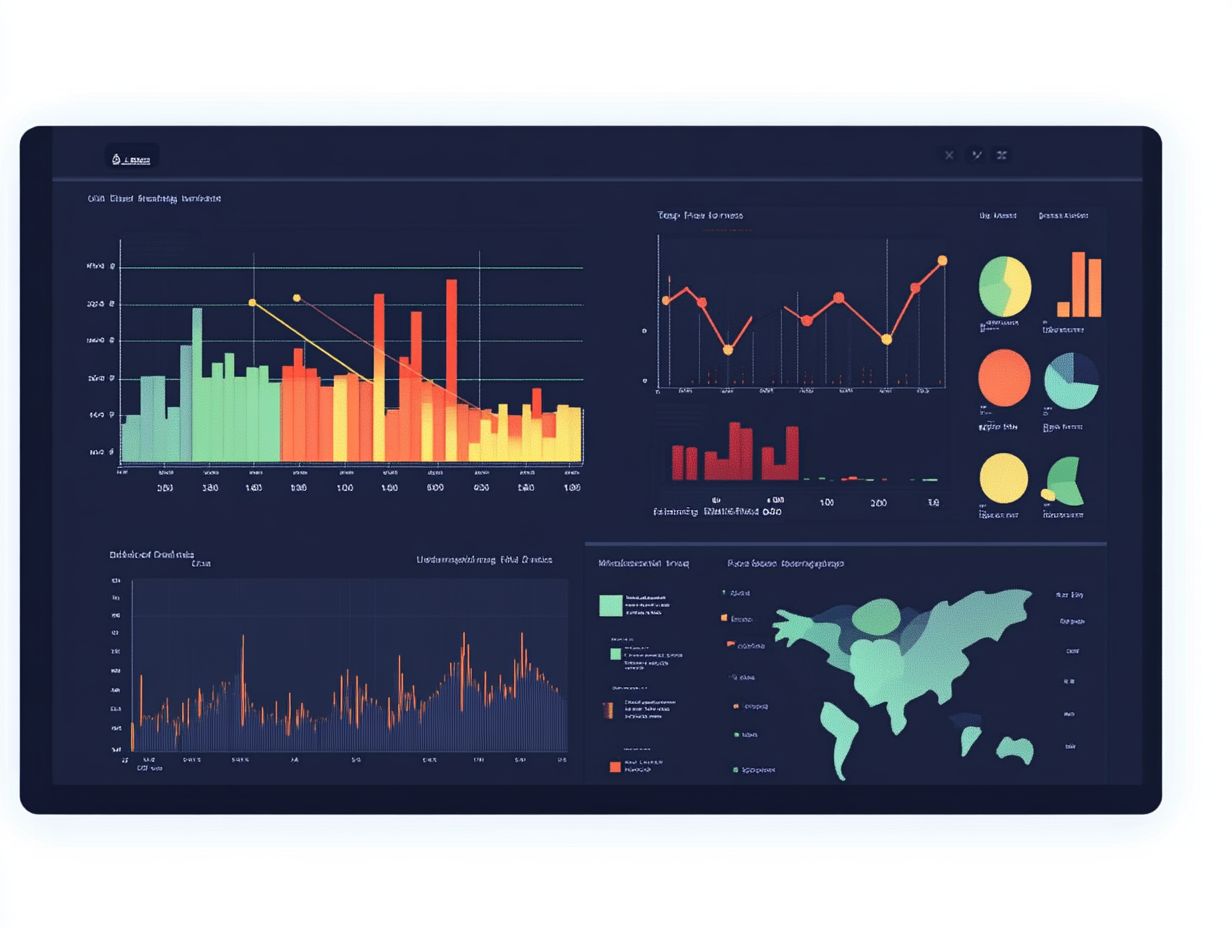key metrics for incident response success
In today s digital landscape, your ability to effectively respond to cybersecurity incidents is crucial, regardless of your organization s size. A robust incident response plan not only reduces potential damage but also enhances your overall security posture.
This article delves into the vital role of incident response in cybersecurity and highlights the key metrics that will help you measure its success.
From analyzing response and resolution times to tracking incident frequency, you ll gain valuable insights into evaluating the effectiveness of your response strategies, ultimately strengthening your organization s defenses.
Contents
- Key Takeaways:
- The Importance of Incident Response
- Key Metrics for Measuring Incident Response Success
- Response Time
- Resolution Time
- Number of Incidents
- Effectiveness of Response Strategies
- Frequently Asked Questions
- What metrics should you track for successful incident response?
- How is Mean Time to Detect (MTTD) calculated?
- What does Mean Time to Respond (MTTR) measure?
- How is Mean Time to Recover (MTTR) calculated?
- Why is it important to track key metrics for incident response success?
- What are some other important metrics to consider for incident response success?
Key Takeaways:

Effective incident response is essential to cybersecurity success. Make sure you’re tracking response times and incident frequency to strengthen your defenses!
Evaluating the effectiveness of different response strategies is important for continuously improving incident response processes.
The Importance of Incident Response
You must recognize the critical role incident response plays in your cybersecurity efforts. As organizations encounter a growing array of threats from cybercriminals, including DDoS attacks, an effective incident response becomes essential.
It not only reduces damage but also ensures that your systems remain available and compliant with Service Level Agreements (SLAs). By adopting robust incident management strategies within a team that monitors and responds to security incidents, you can fortify your digital infrastructure and maintain operational resilience against ever-evolving threats.
Understanding the Role of Incident Response in Cybersecurity
The role of incident response in cybersecurity is absolutely paramount. It enables you to detect, respond to, and recover from the myriad cyber threats that can jeopardize your digital experiences and the integrity of your organization.
By establishing a systematic approach to identify vulnerabilities and understand potential attack vectors, a well-defined incident response process can notably elevate your security posture.
Consider this: cybercriminals often exploit unpatched software and simple human errors, resulting in significant data breaches.
By leveraging tools like SecurityScorecard, you can perform thorough assessments that uncover these weaknesses before they become a problem.
A proactive incident response strategy doesn t just help you mitigate immediate threats; it also equips you with the insights necessary to anticipate future attacks. This makes it essential for protecting sensitive information in an ever-evolving landscape of cyber threats.
Key Metrics for Measuring Incident Response Success
To measure the success of your incident response initiatives, you’ll need to analyze key performance indicators (KPIs) that offer valuable insights into various metrics.
Look at figures like:
- Mean Time to Detect (MTTD) – the average time it takes to find an issue after it occurs.
- Mean Time to Acknowledge (MTTA)
- Mean Time to Recovery (MTTR)
- Mean Time to Contain (MTTC)
These indicators serve a dual purpose: they not only highlight the efficiency of your organization s cybersecurity posture but also guide the ongoing refinement of your incident response strategies.
By doing so, you ensure that your efforts remain in sync with established frameworks like SecurityScorecard.
Defining and Tracking Key Performance Indicators
Defining and tracking key performance indicators (KPIs) for incident response metrics is crucial for organizations like yours that aim to elevate their cybersecurity frameworks and performance assessments.
By establishing a well-defined set of KPIs, you can effectively measure the efficiency of your incident response processes, ensuring you are well-prepared to mitigate potential threats. Metrics such as Mean Time to Respond (MTTR) which calculates the average duration it takes to address incidents post-detection provide valuable insights into your operational readiness and resource allocation.
Monitor the Rate of Incident Closure to evaluate team performance and the overall health of your organization’s security posture.
Keeping an eye on trends over time can unveil patterns, guiding strategic decisions that will enhance your future incident management strategies.
Start evaluating your incident response metrics today to fortify your organization against cyber threats!
Response Time

Response time metrics, particularly the average time it takes to find a problem (MTTD) and the average time to acknowledge an issue (MTTA), are essential for assessing how effectively your organization s incident response protocols function in the cybersecurity landscape.
Measuring the Time it Takes to Detect and Respond to Incidents
Measuring the time it takes to detect and respond to incidents is crucial for understanding your organization’s incident response efficiency.
Focus on key metrics like MTTD and MTTA. By implementing advanced monitoring tools and robust incident response frameworks, you can gain invaluable insights into these metrics.
Techniques such as automated alerts, real-time analytics, and incident logging are instrumental in streamlining your detection and acknowledgment processes.
Consider a major telecommunications provider that embraced continuous monitoring. They dramatically reduced their MTTD, leading to a far more effective incident response strategy.
Delving into case studies shows that a swift acknowledgment of potential threats not only mitigated damages but also reinforced customer trust. This highlights the broader implications for your cybersecurity effectiveness.
Resolution Time
Resolution time metrics, such as the average time to recover (MTTR) and the average time to contain (MTTC), offer critical insights into your organization’s ability to swiftly address incidents and restore normal operations.
Understanding these metrics helps you enhance your incident response strategies and improve overall efficiency.
Monitoring the Time it Takes to Resolve Incidents
Monitoring the time it takes to resolve incidents, especially through MTTR and MTTC, is crucial for evaluating the effectiveness of your incident response strategies.
These metrics are more than just numbers; they re key performance indicators that reveal your operational efficiencies and overall cybersecurity posture.
By closely analyzing MTTR, you can pinpoint lingering vulnerabilities and fine-tune your remediation processes.
MTTC shows how quickly you can neutralize threats, helping to mitigate potential damages. To improve these metrics, consider adopting these best practices:
- Invest in automated monitoring tools
- Provide ongoing training for your incident response teams
- Regularly conduct simulations to enhance your preparedness
As you prioritize these strategies, you ll strengthen your resilience against cyber threats, ensuring a more robust defense against potential breaches.
Number of Incidents
Tracking the number of incidents is an essential metric for understanding the frequency and nature of the cyber threats your organization encounters.
This understanding enables you to refine your incident response strategies and allocate resources more effectively.
Tracking the Frequency of Incidents and Trends Over Time

Tracking the frequency of incidents and trends over time enables you to adapt your incident response metrics and enhance your cybersecurity strategies based on historical data.
By implementing a comprehensive incident management system, you can systematically catalog occurrences and categorize them for deeper insights.
Utilizing analytics tools reveals patterns in incident types, sources, and impacts, allowing you to identify vulnerabilities before they escalate into major issues.
Regularly reviewing these findings creates an environment of continuous improvement. This enables you to take proactive measures instead of merely reacting to problems.
Integrating feedback loops and fostering cross-departmental collaboration ensures that lessons learned are effectively communicated and woven into your training programs and policy updates, ultimately refining your organization s overall security posture.
Effectiveness of Response Strategies
Evaluating the effectiveness of your incident response strategies is crucial for your organization if you want to elevate your cybersecurity posture and establish resilient incident management processes.
This assessment not only strengthens your defenses but also ensures you re well-prepared to handle any eventuality with confidence and efficiency.
Evaluating the Success of Different Response Approaches
Evaluating different incident response methods is essential. It helps you refine your cybersecurity strategies and improve your incident management.
By analyzing frameworks like NIST and SANS, you can identify strengths and weaknesses in your protocols. These methods vary in effectiveness based on the type and severity of incidents, such as data breaches or ransomware attacks.
Key Performance Indicators (KPIs) are crucial for measuring strategy efficiency. They provide insights into response times, recovery times, and the overall impact on your business.
Understanding these metrics allows your team to enhance readiness and adapt to ever-evolving cyber threats.
Frequently Asked Questions
What metrics should you track for successful incident response?
The key metrics for incident response success include:
- Mean Time to Detect (MTTD)
- Mean Time to Respond (MTTR)
- Mean Time to Recover (MTTR)
These metrics measure the efficiency and effectiveness of the incident response process.
How is Mean Time to Detect (MTTD) calculated?

MTTD is calculated by determining the time from when an incident occurs to when it is detected and reported.
What does Mean Time to Respond (MTTR) measure?
MTTR measures the time it takes for the incident response team to respond and start addressing the incident after it has been detected.
How is Mean Time to Recover (MTTR) calculated?
MTTR is calculated by determining the time it takes to fully resolve and recover from an incident.
Why is it important to track key metrics for incident response success?
Track key metrics to boost your response success. This practice allows organizations to assess their incident response processes and identify areas for improvement. To enhance your approach, consider implementing the top 10 incident response best practices. It also helps in setting benchmarks and measuring the overall effectiveness of the incident response plan.
What are some other important metrics to consider for incident response success?
Other important metrics to consider include:
- Number of incidents per month
- Average cost per incident
- Percentage of incidents that are fully resolved
These metrics provide additional insights into the efficiency and effectiveness of the phases of an effective incident response process.






